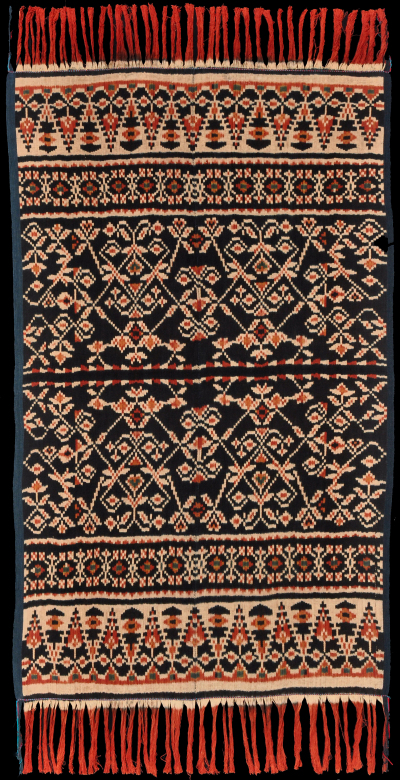| |
042 Roti Group, Roti
Lafa (shawl) 
|
| Locale: | Nemberala village in West Roti (probably). |
| Period: | Circa 1950 |
| Yarn: | Cotton, hand-spun, fine� |
| Technique: | Warp ikat |
| Panels: | 2 |
| Size: | 90 x 155 cm (2' 11" x 5' 1") LW: 1.72 |
| Weight: | 480 g (16.9 oz), 344 g/m2 (1.13 oz/ft2) |
| Design: | Lafa ketemak. Patola inspired motif, branching flowers in two broad bands, and tumpal borders. Executed in two tones of indigo, two tones of morinda red and touches (faded on one face of the cloth) of yellow, which in a few spots creates green through overdyeing of pale indigo. |
| Comment: | Pattern's boldness is enhanced by meticulous weaving. Because yarn was doubled throughout, the feel of the cloth is a ltitle rougher than the fine, very smooth hand spun would make one expect. The deft lima varna (five colours) with yellow accents done in kunyit, turmeric, is restricted to the nobility. Absence of lateral bleeding of the yellow dye shows that the fifth colour was not added after the weaving but actually ikated in. The overall styling and the presence of yellow and tiny patches of green (pale indigo overdyed with indigo) place it firmly in the village of Nemberala, western Roti. |
| Background: | Chapters on Roti Group and Roti. |
| Exhibited: | Hong Kong University Museum and Art Gallery, 2017. |
| Published: | Ikat Textiles of the Indonesian Archipelago, 2018.
|
| Compare: | 011 012 003 141 127 |
| Sources: | Similar to selendang in Tropenmuseum, Nr. 633-4. Also similar to one depicted in Khan-Majlis, Indonesische Textilien, Wege zu Goettern und Ahnen, Fig. 448. |
| |

©Peter ten Hoopen, 2024
All rights reserved.
|


